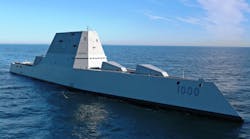U.S. Navy’s DDG 1000, Incorporating an Integrated Power System, Will Make Waves
The future USS Zumwalt (DDG 1000) has begun sea trials in the Atlantic Ocean (Fig. 1). The largest destroyer ever built for the U.S. Navy and the first of three Zumwalt-class destroyers, DDG 1000 will be the first U.S. Navy surface combatant to employ an Integrated Power System (IPS) to generate the total ship electric power requirements, then distribute and convert it for all ship loads from common gas turbine generators. This power flexibility allows for potentially significant energy savings and is well suited to enable future high-energy weapons and sensors. The IPS is a unique design integrating a power system with fight-through power and allowing automatic reconfiguration if there is damage to the power distribution system.
Integrated Power System (IPS)
An integrated power system is an all-electric architecture that provides electric power to the total ship (propulsion and ship service) with an integrated plant. IPS enables a ship’s electrical loads, such as pumps and lighting, to be powered from the same electrical source as the propulsion system (e.g., electric drive). This eliminates the need for separate power generation capabilities for these loads. In commercial applications, this is known as the “power station” concept.
Anticipated benefits of IPS include:
- Fewer prime movers. Usually allows a reduction from a total of seven to five prime movers in the traditional gas-turbine surface combatant.
- Reduced costs of ownership. Results in significant fuel savings (15-19% in a typical gas-turbine combatant). Fewer engines installed results in less maintenance and manning.
- Naval architectural flexibility. Provides flexibility in locating prime movers, allowing space previously used for uptakes to be put to better use.
- Improved survivability and stealth. Quiet propulsion motors can better meet current acoustic requirements. Smaller main machinery spaces allow for improved damage control.
- Improved warfighting. Integrated power makes large amounts of power available throughout the life of the ship. This power can be reallocated to accommodate future combat systems. Advances in power conversion are making it possible to provide uninterrupted power, advanced fault isolation, and fight-through capabilities beyond what is currently available.
In a typical mechanical drive propulsion system, the propulsion prime movers are connected to long shafts running through the ship to large reduction gears that rotate the ship's propellers. With electric drive, the prime movers rotate electric generators that are connected through cabling to motor drives and electric motors that rotate a ship’s propellers. Electricity is the medium for transmitting the energy of the prime mover. It enables “cross-connecting” of any available prime mover/generator combination by breaking the physical link between the power generation and power utilization components.
IPS provides for all of a ship’s electrical needs, including propulsion and ship service loads. Traditional electric drives only provide for propulsion. They do not include power for ship service loads.
The Navy has used electric drive in many ships, including early aircraft carriers, a number of ships during World War II, and many of the current inventory of smaller auxiliary ships. In fact, the Navy is leveraging as much as possible from the cruise-ship industry, where nearly all new ships employ integrated electric systems. What is new and significant is the application of these concepts in a fully electrically integrated (no mechanical takeoffs for power) power system on a surface combatant. These ships have higher speed and lower noise requirements than any of the other ships, as well as large combat systems to support. Commercial cruise ships would be too big and too noisy for a surface combatant, and do not have a power system architecture to let them survive damage and continue to fight.
Training Required
The new crew trained on components including main and auxiliary turbine generators, propulsion motors and drives, dynamic braking resistors, auxiliary control panels, and high-voltage switchboards. They also spent time working with harmonic filters, neutral ground resistors, the Integrated Fight-Through Power System (IFTP), power conversion modules, and an emergency diesel generator.
Equipment operation was conducted at the local control level, as well as the remote supervisory Engineering Control System (ECS). The ECS system provides a significant advancement in machinery control with automation for system transitions and power management to support the reduced manning concept for the DDG 1000.
DDG 1000’s power allocation flexibility allows for potentially significant energy savings and is well-suited to enable future high energy weapons and sensors.
Its wave-piercing Tumblehome ship design has provided a wide array of advancements. The composite superstructure significantly reduces cross-section and acoustic output, making the ship harder to detect by enemies at sea. The design also allows for optimal manning with a standard crew size of 158 sailors (including air detachment) thereby decreasing lifecycle operations and support costs.
DDG 1000 will employ active and passive sensors and a Multi-Function Radar (MFR) capable of conducting area air surveillance, including over-land, throughout the extremely difficult and cluttered sea-land interface.
Each ship features a battery of two Advanced Gun Systems (AGS) firing Long-Range Land Attack Projectiles (LRLAP) that reach up to 63 nautical miles, providing a three-fold range improvement in naval surface firepower coverage.
The Navy intends to procure three Zumwalt Class Destroyers, which are named in honor of former Chief of Naval Operations, Elmo R. “Bud” Zumwalt Jr.
Construction of all three members of this class of destroyers is now under way. Construction on DDG 1000 (Zumwalt) began in February 2009. Launch of the ship occurred on Oct. 29, 2013. The ship is currently conducting hull, mechanical, and electrical (HM&E) test.
DDG 1001 was named Michael Monsoor in October 2008 by then-Secretary of the Navy Donald Winter, honoring Petty Officer 2nd Class Michael Monsoor, a Navy SEAL who was posthumously awarded the Medal of Honor for his heroic actions in Ramadi, Iraq, Sept. 29, 2006. DDG 1001 start of fabrication took place in October 2009. In July 2014, Huntington Ingalls Industries (HII) delivered the DDG 1001 composite deckhouse to the Navy.
In April 2012, DDG 1002 was named Lyndon B. Johnson by Secretary of the Navy Ray Mabus. The selection of Lyndon B. Johnson honors the nation’s 36th president and continues the Navy tradition of naming ships after presidents. DDG 1002 start of fabrication took place April 4, 2012.
The ship has a mission center instead of the standard “bridge” most ships have. Its state-of-the art consoles and communications equipment make the Zumwalt unique in having secure networking that allows the ship's captain to control all manner of systems from anywhere on board.
After the sea trials, the ship will delivered to the Navy, where it will then undergo testing and trials until becoming operational around 2016.
Developers
- General Dynamics Bath Iron Works Bath, Maine
- Huntington Ingalls Industries Pascagoula, Miss.
- Raytheon Systems Inc. Sudbury, Mass.
- BAE Systems Minneapolis, Minn.
- More than 80 companies nationwide, including Lockheed Martin, are also involved with DDG 1000.


